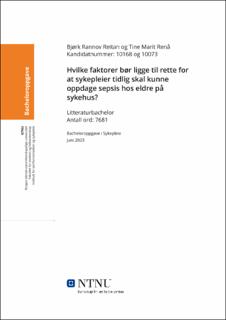| dc.contributor.advisor | Lindset, Marit | |
| dc.contributor.author | Reitan, Bjørk Rannov | |
| dc.contributor.author | Renå, Tine Marit | |
| dc.date.accessioned | 2023-07-20T17:19:32Z | |
| dc.date.available | 2023-07-20T17:19:32Z | |
| dc.date.issued | 2023 | |
| dc.identifier | no.ntnu:inspera:146721298:147643805 | |
| dc.identifier.uri | https://hdl.handle.net/11250/3080553 | |
| dc.description.abstract | Bakgrunn og hensikt/problemstilling: Både antallet og andelen eldre i befolkningen øker stadig, samtidig som at eldre er en gruppe som er utsatt for å utvikle sepsis. Dersom sykepleier på sykehus tidlig oppdager sepsis hos denne gruppen kan det hindre død og bidra til at eldre holder seg friske og selvhjulpne lenger. Dette kan bidra til å redusere belastningen på helse- og omsorgstjenestene. Hensikten med oppgaven er å undersøke hvilke faktorer som bør ligge til rette for at sykepleier tidlig skal kunne oppdage sepsis hos eldre på sykehus.
Metode: Oppgaven er en systematisk litteraturstudie som inkluderer ni forskningsartikler. Oppgaven er skrevet i perioden mars 2023 til juni 2023. Som støtte til oppgaven er det blitt brukt annen relevant forskning og faglitteratur.
Resultat: Eldre viser seg å ha et mer komplekst sykdomsbilde ved sepsis, og kartleggingsverktøyene er i mindre grad tilpasset tidlig oppdagelse hos denne pasientgruppen. Innføring av standardiserte protokoller og undervisningstiltak tilpasset den eldre pasient førte til at sykepleiere tidligere oppdaget tegn på sepsis, noe som førte til tidligere iverksettelse av tiltak og reduserte omfanget av sykdom og død.
Konklusjon: Kartleggingsverktøy for sepsis er ikke godt nok tilpasset den eldre pasienten, men standardiserte protokoller kan øke oppdagelsen av sepsis. Sykepleieres kliniske kompetanse kan være avgjørende for å tidlig oppdage sepsis hos eldre på sykehus, og undervisning om sepsis øker sykepleiers kliniske kompetanse. | |
| dc.description.abstract | Background and aim/research question: Both the number and proportion of elderly individuals in the population are continuously increasing, while the elderly are a group vulnerable to developing sepsis. If nurses in hospitals can early detect sepsis in this group, it can prevent deaths and contribute to keeping the elderly healthier and more self-reliant for a longer period. This can help reduce the burden on healthcare services. The purpose of the study is to investigate the factors that should be in place for nurses to be able to detect sepsis early in older patients in hospitals.
Method: This study is a systematic literature review that includes nine research articles. The study was conducted between March 2023 and June 2023. Other relevant research and academic literature were used as support for the study.
Results: The elderly population presents a more complex disease profile when it comes to sepsis, and the assessment tools are less adapted for early detection in this patient group. The implementation of standardized protocols and tailored educational interventions for the elderly patients led to earlier detection of sepsis signs by nurses, resulting in earlier implementation of interventions and reduced severity of illness and mortality.
Conclusion: Sepsis assessment tools are not sufficiently tailored to the elderly patient, but standardized protocols can enhance sepsis detection. Nurses' clinical competence can be crucial in the early detection of sepsis in elderly patients in hospitals, and education about sepsis enhances nurses' clinical competence. | |
| dc.language | nob | |
| dc.publisher | NTNU | |
| dc.title | Hvilke faktorer bør ligge til rette for at sykepleier tidlig skal kunne oppdage sepsis hos eldre på sykehus? | |
| dc.type | Bachelor thesis | |
